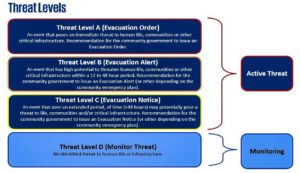“But I’ve seen this myself … Elders from Northern communities were scavenging the (hotel) hallways eating (room service) leftovers, because they had no other assistance available.”
– An evacuee told a KPMG public forum in March
Should the capital region be evacuated again for a disaster of any type, particular attention will be given to Indigenous people, especially Elders, says a new Evacuation Plan released today by the City of Yellowknife.
Along with a Community Emergency Plan, the updated plans total just over 80 pages and draw on recommendations from the KPMG After-Action Assessment of the 2023 Wildfire Response, which was critical of the city’s lack of planning.

A map showing the scope of Yellowknife’s Community Emergency and Evacuation Plans. (Image courtesy City of Yellowknife)
That focus on the safe and culturally appropriate evacuation measures for Indigenous peoples living in Yellowknife and Ndilǫ is a response to several complaints, many of which were heard at a public meeting last March into the City of Yellowknife’s response to the 2023 wildfire season. Particular attention is needed to ensure safe and culturally appropriate evacuation measures for First Nation Elders, reads the Evacuation Plan.
Some Elders may have never left their community for extended periods before, so ensuring that Elders remain together throughout all evacuation phases can be helpful, states the report.
“Elders also may not speak English or French, and therefore communications should be made available in local Indigenous languages, when possible.”
The plan notes that many Indigenous residents in the capital district of the North Slave region are members of the Yellowknives Dene First Nation and Tłı̨chǫ First Nation and both governments provide supports for their members during evacuation.
However, the City of Yellowknife should consider support for members of these communities living in the city borders, residents of N’Dilo that rely on city services and resources, and members of other Indigenous communities.
Although wildfires pose the greatest risk, other hazards that have the potential to affect the city include power failure, telecommunications failure, water supply issues, human disease and epidemics, industrial emergencies, transportation incidents (road, air, marine), severe weather, space debris, and winter storms.
The report states that the city should coordinate communication and evacuation efforts with the Indigenous governments. This includes issuing joint communications when possible.
Yellowknife also has a significant vulnerable population who face many challenges related to a lack of affordable housing, addiction, and mental health issues. They require different methods of evacuation communications, such as through NGOs that work with them. So, connect with organizations providing support to Indigenous community members within the city, including the Native Women’s Association and Tree of Peace Friendship Centre.
In the event of an emergency, special considerations are necessary to support the safe evacuation of seniors residing in long-term care homes and those living alone or with family.
Special attention is needed for seniors living alone to ensure they have access to necessary information and are not left behind, states the report. Many seniors may rely on print media or word-of-mouth from neighbours and family members, more than other sources such as social media.

Evacuation plan threat levels. (Image courtesy City of Yellowknife. (Image courtesy City of Yellowknife)
AVENS Senior Centre is the only assisted living, long-term care facility in Yellowknife.
An internal post-wildfire review found that throughout the evacuation and repatriation, AVENS staff faced a continual barrage of unforeseen and unanticipated events, resulting in a high level of stress and uncertainty for the duration of the evacuation.
The updated city plan calls for local community staff to be evacuated with their residents, if possible, so they can provide support to for their residents wherever they are hosted.
For survivors of domestic and sexual violence, as well as people protected by court-issued protection orders, safety considerations are needed to reduce the risk of further violence occurring during an evacuation, states the report
Those residing in community shelters for protection from domestic or sexual violence may have to move to emergency shelters during emergencies. Extra care is needed for these survivors, especially in managing their personal identifiable information.
This includes safeguarding shelter registrations, avoiding the exposure of client data, and ensuring sufficient space between registering shelter clients. Alternative housing options could include temporary stays in motels or hotels, or other direct placement programs that offer secure housing.
Consideration is also needed for the evacuation of domestic animals, both for pet well-being and to reduce stress for their owners.
While the care of people takes precedence over care of domestic animals, the two are often directly linked, states the report. Providing pet care information during evacuation can reduce the decisions of community members to remain in evacuated areas due to unwillingness to abandon pets.
Previous disasters have demonstrated that co-evacuating people with their pets increases compliance with evacuation orders, increases survivor resilience, and decreases re-entry to unsafe areas motivated by animal rescue. Domestic animals are the direct responsibility of the owner, who should provide carrying cases/cages/leashes, medications, and basic food and water as required.
The plans can be read in full on the city’s website.

Pets are the responsibility of their owners, but should also be evacuated, says new plan. Here, Canadian Forces members help NWT passengers arriving at Edmonton International Airport, in August 2023. (Photo courtesy of MCpl Paul McCahon, CAF/JTFC)





